(I assume that $K$ is a field)
Decompose each $f_m$ into a product of irreducible series $f_m=g^1_m\dots g^{i_m}_m$. For each $m$ we get $f_m=\overline{g^{1}_{m+1}}\dots \overline{g^{i_{m+1}}_{m+1}}$ where overline denotes the reduction map $K[[x_1,\dots, x_m,x_{m+1}]]\to K[[x_1,\dots, x_m]]$. Since $K[[x_1,\dots,x_m]]$ is a UFD, $\overline{g^j_{m+1}}$ is a product of some elements $g^{k_1},\dots ,g^{k_{n_{j,m+1}}}$ up to a unit. More precisely, decompositions of $f_m$s give a sequence of partitions of the set $\{1,\dots, i_1\}$ such that the $m$-th partition is a refinement of the $(m+1)$-th for every $m$.
If there are no $N$ such that for every $m>N$ the series $f_m$ is irreducible, all these partitions consist of at least two elements. However, the sequence of positive integers $i_1\geq i_2\geq \dots$ must stabilize eventually, so there is a number $N$ such that for every $m\geq N$ we get (maybe after permuting the irreducible factors) $\overline{g^k_{m+1}}=g^k_mu^k_m$ where $u^k_m$ are units such that $u^1_{m}\dots u^{i_m}_{m}=1$. We will now modify the decompositions to obtain a decomposition of $f$. Namely for each $m\geq {N-1}$, put $h^k_{m+1}=g^{k}_{m+1}\cdot (\iota(u^k_N)\iota(u^{k}_{N+1})\dots \iota(u^{k}_{m}))^{-1}$ where $\iota^{m+1}_{l}:K[[x_1,\dots, x_l]]\to K[[x_1,\dots, x_{m+1}]]$ are the embeddings.
We've arranged things so that $f_{m}=h^{1}_m\dots h^{i}_m$ for all $m\geq N$ ($i$ is the stabilizing value of the sequence $(i_m)$) and $\overline{h^k_{m+1}}=h^k_m$. Hence, we get non-invertible elements $h^k$ of $K[[x_1,\dots]]$ such that $f=h^1\dots h^i$ so $f$ is reducible.

